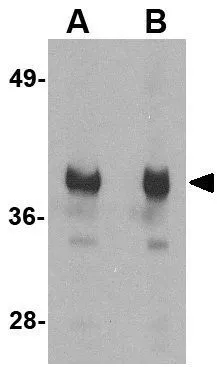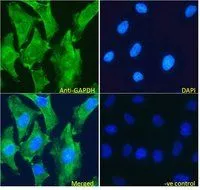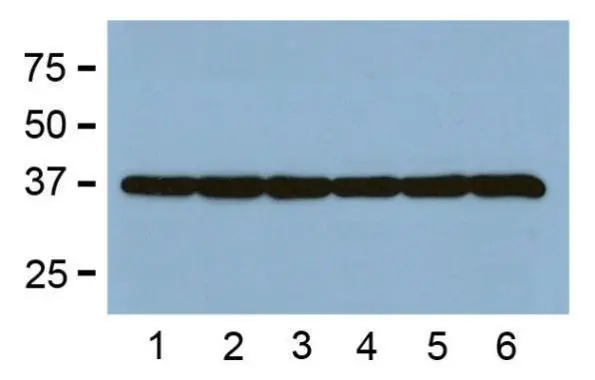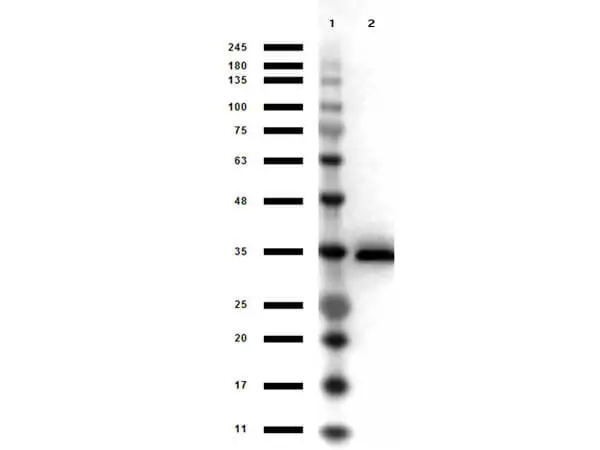
WB analysis of HeLa cell lysate using GTX85118 GAPDH antibody. Working concentration : (A) 1 and (B) 2 microg/ml
GAPDH antibody
GTX85118
ApplicationsWestern Blot, ELISA
Product group Antibodies
TargetGAPDH
Overview
- SupplierGeneTex
- Product NameGAPDH antibody
- Delivery Days Customer9
- Application Supplier NoteWB: 1 - 2 microg/mL. *Optimal dilutions/concentrations should be determined by the researcher.Not tested in other applications.
- ApplicationsWestern Blot, ELISA
- CertificationResearch Use Only
- ClonalityPolyclonal
- Concentration1 mg/ml
- ConjugateUnconjugated
- Gene ID2597
- Target nameGAPDH
- Target descriptionglyceraldehyde-3-phosphate dehydrogenase
- Target synonymsG3PD, GAPD, HEL-S-162eP, glyceraldehyde-3-phosphate dehydrogenase, OCAS, p38 component, Oct1 coactivator in S phase, 38 Kd component, aging-associated gene 9 protein, epididymis secretory sperm binding protein Li 162eP, peptidyl-cysteine S-nitrosylase GAPDH
- HostChicken
- IsotypeIgY
- Protein IDP04406
- Protein NameGlyceraldehyde-3-phosphate dehydrogenase
- Scientific DescriptionGlyceraldehyde-3-phosphate dehydrogenase (GAPDH) catalyzes the reversible oxidative phosphorylation of glyceraldehyde-3-phosphate in the presence of inorganic phosphate and nicotinamide adenine dinucleotide (NAD), an important energy-yielding step in carbohydrate metabolism. Recent evidence suggests that it also is involved in a number of cellular processes such as membrane fusion, phosphotransferase activity, DNA replication and repair, and nuclear RNA export. GAPDH has also been implicated in playing a role in different pathologies such as cancer progression, apoptosis, and neuronal diseases such as Alzheimers and Huntingtons disease. GAPDH is constitutively expressed at high levels in almost all tissues and cell lines making it ideal for use as a loading control marker in immunoblots.
- Storage Instruction-20°C or -80°C,2°C to 8°C
- UNSPSC12352203
References
- Exploring mechanisms of increased cardiovascular disease risk with antipsychotic medications: Risperidone alters the cardiac proteomic signature in mice. Beauchemin M et al., 2020 Feb, Pharmacol ResRead more
- Golgi stress-induced transcriptional changes mediated by MAPK signaling and three ETS transcription factors regulate MCL1 splicing. Baumann J et al., 2018 Jan 1, Mol Biol CellRead more

![WB analysis of multiple cell and tissue lysates (Lanes 1-23 : 293, A431, A549, Daudi, HeLa, HepG2, Jurkat, K562, MOLT, 3T3, Raji, Ramos, U937, human brain, mouse brain, rat brain, rabbit brain, human heart, rat heart, human liver, mouse liver, rat liver, rabbit liver) using GTX17307 GAPDH antibody [12D3H9]. Working concentration : 1 microg/ml](https://www.genetex.com/upload/website/prouct_img/normal/GTX17307/GTX17307_2440_WB_20180221_w_23060620_283.webp)
![ICC/IF analysis of methanol-fixed HepG2 (left) and HeLa (right) cells using GTX83245 GAPDH antibody [1A10]. Green : GAPDH Blue: DRAQ5 fluorescent DNA dye](https://www.genetex.com/upload/website/prouct_img/normal/GTX83245/GTX83245_20170912_ICCIF_w_23061322_576.webp)



![ICC/IF analysis of HeLa cells using GTX33615 GAPDH antibody [RM114]. Red : Primary antibody Green : Actin Blue : DAPI Dilution : 1:200](https://www.genetex.com/upload/website/prouct_img/normal/GTX33615/GTX33615_20200909_ICCIF_162_w_23060800_928.webp)
